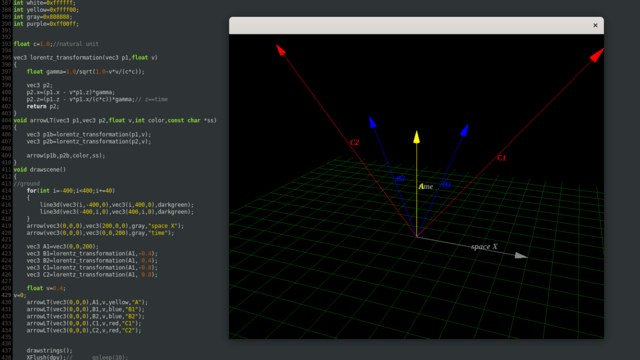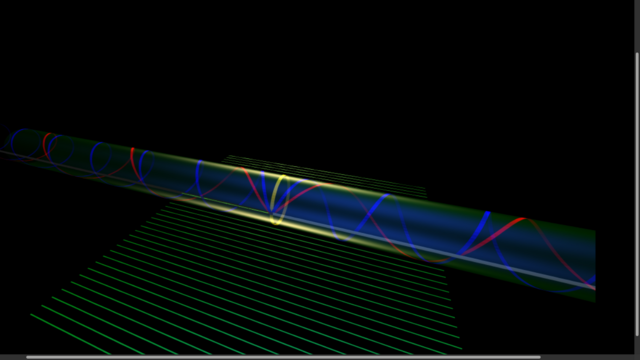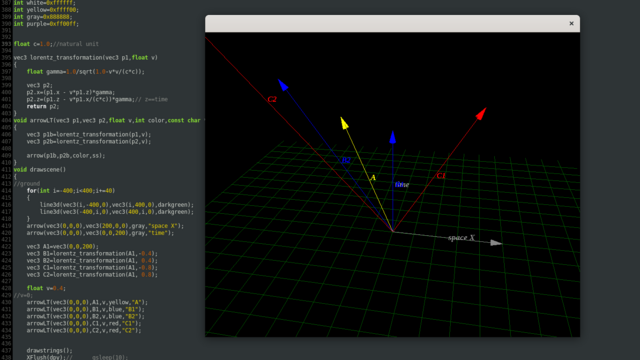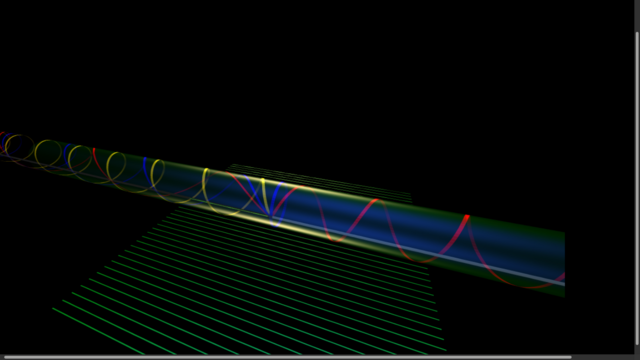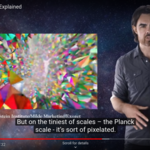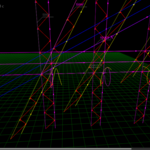
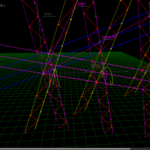
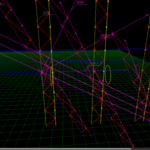
<!doctype html>
<html>
<body>
<canvas width="1000" height="600" id="my_Canvas"></canvas>
<script>
/*============= Creating a canvas ======================*/
var iradian = Math.PI / 180.0;
var canvas = document.getElementById('my_Canvas');
//gl = canvas.getContext('experimental-webgl');
var ctx = canvas.getContext("2d");
ctx.imageSmoothingEnabled = false;
ctx.translate(0.5, 0.5);
var wx = canvas.width, wy = canvas.height;
var demomode = 1;
var operatemode=0;
var zoom=320.0;
var spaceview=0;
// ##############################
// vector class
// ##############################
function vec3(vx, vy, vz) {
this.x = vx || 0;
this.y = vy || 0;
this.z = vz || 0;
};
vec3.copy = function (v1) {
var e = new vec3;
e.x = v1.x;
e.y = v1.y;
e.z = v1.z;
return e;
};
vec3.add = function(a,b) {
if (b instanceof vec3) {return new vec3(a.x+b.x,a.y+b.y,a.z+b.z );}// parm vec3
else {return new vec3(a.x+b ,a.y+b ,a.z+b );}// parm scalar
return b;
};
vec3.sub = function(a,b) {
if (b instanceof vec3) {return new vec3(a.x-b.x,a.y-b.y,a.z-b.z );}
else {return new vec3(a.x-b ,a.y-b ,a.z-b );}
return this;
};
vec3.mul = function(a,b) {
if (b instanceof vec3) {return new vec3(a.x*b.x,a.y*b.y,a.z*b.z );}
else {return new vec3(a.x*b ,a.y*b ,a.z*b );}
return this;
};
vec3.div = function(a,b) {
if (b instanceof vec3) {return new vec3(a.x/b.x,a.y/b.y,a.z/b.z );}
else {return new vec3(a.x/b ,a.y/b ,a.z/b );}
return this;
};
vec3.dot = function (v1, v2) { return v1.x * v2.x + v1.y * v2.y + v1.z * v2.z; };
vec3.cross = function (v1, v2) {
return new vec3(
v1.y * v2.z - v1.z * v2.y,
v1.z * v2.x - v1.x * v2.z,
v1.x * v2.y - v1.y * v2.x);
};
vec3.lengthV = function(v1) {
return Math.sqrt(vec3.dot(v1, v1));
};
vec3.normalize = function (v1) {
var len = vec3.lengthV(v1);
return new vec3(v1.x / len, v1.y / len, v1.z / len);
};
var v1 = new vec3(70, 50, 100);
var camx = new vec3(1, 0, 0);
var camy = new vec3(0, 1, 0);
var camz = new vec3(0, 0, 1);
var origo = new vec3(0, 0, 0);
var eye = new vec3(0, 0, 0);
var look = new vec3(80, 0, 00);
var e1 = new vec3(1, 0, 0);// basis vectors
var e2 = new vec3(1, 2, 0); e2 = vec3.normalize(e2);
var e3 = new vec3(0, 0, 1);
var velocity=0;
var velocity2=0;
// ##############################
// mouse handle
// ##############################
var drag = false;
var old_x, old_y;
var dX = 0, dY = 0;
var alpha1 = 277 * iradian;
var alpha2 = 20 * iradian;
var mouseDown = function (e) {
drag = true;
old_x = e.pageX, old_y = e.pageY;
e.preventDefault();
chkmenu(e.offsetX,e.offsetY);
return false;
};
var mouseUp = function (e) {
drag = false;
};
var mouseMove = function (e) {
if (!drag) {chkmenu(e.offsetX,e.offsetY);return false;}
dX = (e.offsetX - old_x) * 2 * Math.PI / canvas.width,
dY = (e.offsetY - old_y) * 2 * Math.PI / canvas.height;
if(operatemode==0)
{
alpha1 += dX;
alpha2 += dY;
}
if(operatemode==1)
{
zoom+=dY*30.0;
}
if(operatemode==2)
{
velocity -= dX*0.05;// right to +v
}
if(operatemode==3)
{
velocity2 -= dX*0.05;// right to +v
}
old_x = e.offsetX, old_y = e.offsetY;// page
e.preventDefault();
animate(0);
};
var mouseWheel = function(e) {
//NA scroll zoom+=e.deltaY*5.0;
}
var doKeyDown = function (e) {
// if (e.keyCode == 49) { demomode = 1; }// 1
// if (e.keyCode == 50) { demomode = 2; }
// if (e.keyCode == 51) { demomode = 3; }
}
canvas.addEventListener("mousedown", mouseDown, false);
canvas.addEventListener("mouseup", mouseUp, false);
canvas.addEventListener("mouseout", mouseUp, false);
canvas.addEventListener("mousemove", mouseMove, false);
canvas.addEventListener("wheel", mouseWheel, false);
window.addEventListener("keypress", doKeyDown, false);
// ##############################
// lines gfx
// ##############################
function qprint(xc, yc, str, color) {
ctx.font = "15px Comic Sans MS";
ctx.fillStyle = color;// '#ffff00';
ctx.textAlign = "left";
ctx.fillText(str, xc, yc);
}
function line(x1, y1, x2, y2, color)
{
ctx.beginPath();
ctx.moveTo(x1, y1);
ctx.lineTo(x2, y2);
ctx.strokeStyle=color;
ctx.stroke();
}
function transf3d(v1)
{
var sc = new vec3(0, 0, 0);
var w1 = new vec3(0, 0, 0);
w1.x = v1.x - eye.x;
w1.y = v1.y - eye.y;
w1.z = v1.z - eye.z;
sc.x = vec3.dot(w1, camx);
sc.y = vec3.dot(w1, camy);
sc.z = vec3.dot(w1, camz);
var zoom = 500;
sc.x = wx / 2 + sc.x * zoom / sc.z;
sc.y = wy / 2 - sc.y * zoom / sc.z;
return sc;
}
function line3d(v1, v2, color)
{
var sc1 = transf3d(v1);
var sc2 = transf3d(v2);
if (sc1.z > 0.0)
if (sc2.z > 0.0)
line(sc1.x, sc1.y, sc2.x, sc2.y, color);
}
var ori=0;
function arrow3d(v1, v2, color,str)
{
var sc1 = transf3d(v1);
var sc2 = transf3d(v2);
var sc3 = new vec3;
sc3.x = (sc1.x + sc2.x) / 2.0;//center
sc3.y = (sc1.y + sc2.y) / 2.0;
sc3.z = (sc1.z + sc2.z) / 2.0;
if (sc1.z > 0.0)
if (sc2.z > 0.0) {
var sc4 = new vec3;
var sc5 = new vec3;
line(sc1.x, sc1.y, sc2.x, sc2.y, color);
sc4 = vec3.copy(sc3);
sc4.x += 20.0;
if(ori==0) sc4.y -= 20.0;
else sc4.y += 20.0;
sc5 = vec3.copy(sc4);
sc5.x += 40.0;
if(str!="")
{
line(sc3.x, sc3.y, sc4.x, sc4.y, '#777777');// pointing
line(sc4.x, sc4.y, sc5.x, sc5.y, '#777777');
}
//arrow head
var xaxis=new vec3;
var yaxis=new vec3;
var zaxis=new vec3;
yaxis=vec3.sub(v2,v1);
yaxis=vec3.normalize(yaxis);
xaxis=vec3.normalize(vec3.cross(yaxis,new vec3(yaxis.z,yaxis.x,yaxis.y)));
zaxis=vec3.normalize(vec3.cross(xaxis,yaxis));
var v4=new vec3;
var k,u=12,sc=3.05;
for(var k=0;k<u;k++)
{
var aa=k*Math.PI*2.0/u;
v4=vec3.sub(v2,vec3.mul(xaxis,Math.cos(aa)*sc*0.3));
v4=vec3.sub(v4,vec3.mul(zaxis,Math.sin(aa)*sc*0.3));
v4=vec3.sub(v4,vec3.mul(yaxis,sc));
line3d(v2,v4,color);
}
// text
sc4.y -= 5.0;
if(str!="")
qprint(sc4.x, sc4.y,str,color);
}
ori=0;
}
function circle3d(p1,p2,color)
{
var r=20.0;
var p4=p1;
for(var i=0;i<41;i+=1)
{
var p3=vec3.sub(p2,p1);
p3=vec3.mul(p3,i/40.0);
var p6=vec3.add(p1,p3);// p3=p1+(p2-p1)*i/40
var ok=0;
if(p6.z>0.0)
if(p6.z<50.0) ok=1;
var aa=i*Math.PI*2.0/40.0;
p6.y=Math.cos(aa)*r-30.0;
p6.z=Math.sin(aa)*r;
if(ok==1)
if(i!=0) line3d(p6,p4,color);
p4=p6;
}
}
function circle3dold(p1,p2,color)
{
var r=20.0;
var p4=p1;
for(var i=0;i<40;i+=1)
{
var p3=vec3.sub(p2,p1);
p3=vec3.mul(p3,i/40.0);
p3=vec3.add(p1,p3);
var p33=p3;
var aa=i*Math.PI*2.0/40.0;
p33.y=Math.cos(aa)*r-30.0;
p33.z=Math.sin(aa)*r;
if(p3.z>-50.0)
if(p3.z<50.0)
if(i!=0) line3d(p33,p4,color);
p4=p33;
}
}
function sphere(alf1, alf2, ra)
{
return new vec3(
ra * Math.cos(alf1) * Math.cos(alf2),
ra * Math.sin(alf1) * Math.cos(alf2),
ra * Math.sin(alf2));
}
// ##############################
// menu
// ##############################
var menus=["lightclock","lightcones","space view","transf U(1)","Reciprocity","rot camera","zoom","velocity","vel 3rd RF"];
var xm,ym,nn,nm;
var xh=100,yh=18;
var itemsx=[];
var itemsy=[];
var itemsena=[];
function itermenu(value)
{
ctx.fillStyle = '#555555';
ctx.fillRect(xm, ym, xh, yh);
var col1='#ffffff';
var col2='#777777';
if(itemsena[nn]==1) {var q=col1;col1=col2;col2=q;}
line(xm,ym,xm+xh,ym,col1);
line(xm,ym,xm,ym+yh,col1);
line(xm,ym+yh,xm+xh,ym+yh,col2);
line(xm+xh,ym,xm+xh,ym+yh,col2);
qprint(xm+5,ym+14,value,'#ffffff');
itemsx[nn]=xm;
itemsy[nn]=ym;
ym+=27;
nn+=1;
}
function updatemenu()
{
xm=30;ym=100;nn=0;
menus.forEach(itermenu);
nm=nn;
}
function chkmenu(x,y)
{
var i,j;
for(i=0;i<nm;i++)
{
// itemsena[i]=0;
if(x>=itemsx[i])
if(x<=itemsx[i]+xh)
if(y>=itemsy[i])
if(y<=itemsy[i]+yh)
{
var ll=5;//separator
if(i<ll) for(j=0;j<ll;j++) itemsena[j]=0;//clear radio button style
else for(j=ll;j<nm;j++) itemsena[j]=0;
itemsena[i]=1;
if(i<ll) demomode=i+1;
else operatemode=i-ll;
animate(0);
}
}
}
// ##############################
// special relativity
// ##############################
var c=1,v1=0; // natural unit
function lorentz_transformation(p1,v)
{
var gamma=1.0/Math.sqrt(1.0-v*v/(c*c));
var p2=new vec3(0,0,0);
p2.x=(p1.x - v*p1.z)*gamma;
p2.y=p1.y;
p2.z=(p1.z - v*p1.x/(c*c))*gamma;// z==time component
return p2;
}
function arrowLT(p1,p2,color,ss)
{
var p1b=lorentz_transformation(p1,v1);
var p2b=lorentz_transformation(p2,v1);
if(spaceview==1) {p1b.z=0;p2b.z=0;}
arrow3d(p1b,p2b,color,ss);
}
function arrowU1(p1,p2,color,ss)
{
var p1b=lorentz_transformation(p1,v1);
var p2b=lorentz_transformation(p2,v1);
if(spaceview==1) {p1b.z=0;p2b.z=0;}
circle3d(p1b,p2b,color);
}
function qprint3d(p1,str,color)
{
var sc1 = transf3d(p1);
qprint(sc1.x, sc1.y,str,color);
}
function qprintLT(p1,str,color)
{
var p1b=lorentz_transformation(p1,v1);
// if(str!="")
qprint3d(p1b,str,color);
}
// ##############################
// main function
// ##############################
function drawscene()
{
// camera setup
camz.x = look.x - eye.x;
camz.y = look.y - eye.y;
camz.z = look.z - eye.z;
camz = vec3.normalize(camz);
camy = new vec3(0, 0, 1);
camx = vec3.cross(camz, camy);
camx = vec3.normalize(camx);
camy = vec3.cross(camx, camz);
camy = vec3.normalize(camy);
// background
var h=10;
for (var y = -300; y < 300; y += h)
for (var x = -300; x < 300; x += h)
{
line3d(new vec3(x, y,0), new vec3(x+h, y,0), '#005500');
line3d(new vec3(x, y,0), new vec3(x, y + h,0), '#005500');
}
var gray='#555555';
var red='#ff0000';
var darkred='#880000';
var green='#00cc00';
var darkgreen='#007700';
var purple='#ff00ff';
var blue='#0000ff';
var darkpurple='#880088';
var yellow='#ffff00';
var darkyellow='#888800';
// example code
v1=velocity;
if (demomode == 2)
{
for(var i=0;i<20;i++)
{
var aa=i*Math.PI*2/20.0;
var r=100.0;
var c1=r*Math.cos(aa);
var s1=r*Math.sin(aa);
arrowLT(new vec3(0,0,0),new vec3(s1,c1,100),darkred,"");
arrowLT(new vec3(s1,c1,100),new vec3(0,0,200),darkred,"");
arrowLT(new vec3(0,0,200),new vec3(s1,c1,300),darkred,"");
}
qprint(30, 45, "light cones", '#ffffff');
}
if (demomode == 1 ||demomode == 2)
{
arrowLT(new vec3(0,0,0),new vec3(0,0,300),green,"mirror1");
arrowLT(new vec3(100,0,0),new vec3(100,0,300),green,"mirror2");
arrowLT(new vec3(0,0,0),new vec3(100,0,100),red,"light");
arrowLT(new vec3(100,0,100),new vec3(0,0,200),red,"light");
arrowLT(new vec3(0,0,200),new vec3(100,0,300),red,"light");
arrowLT(new vec3(0,100,0),new vec3(0,100,300),green,"mirror3");
arrowLT(new vec3(0,0,0),new vec3(0,100,100),red,"light");
arrowLT(new vec3(0,100,100),new vec3(0,0,200),red,"light");
arrowLT(new vec3(0,0,200),new vec3(0,100,300),red,"light");
if (demomode == 1)
qprint(30, 45, "light clock", '#ffffff');
}
if (demomode == 3)
{
arrowLT(new vec3(0,0,0),new vec3(0,0,300),darkgreen,"mirror1");
/* arrowLT(new vec3(100,0,0),new vec3(100,0,300),green,"mirror2");
arrowLT(new vec3(0,0,0),new vec3(100,0,100),red,"light");
arrowLT(new vec3(100,0,100),new vec3(0,0,200),red,"light");
arrowLT(new vec3(0,0,200),new vec3(100,0,300),red,"light");*/
arrowLT(new vec3(0,100,0),new vec3(0,100,300),darkgreen,"mirror3");
arrowLT(new vec3(0,0,0),new vec3(0,100,100),darkred,"light");
arrowLT(new vec3(0,100,100),new vec3(0,0,200),darkred,"light");
arrowLT(new vec3(0,0,200),new vec3(0,100,300),darkred,"light");
spaceview=1;
arrowLT(new vec3(0,0,0),new vec3(0,0,300),green,"mirror1");
arrowLT(new vec3(0,100,0),new vec3(0,100,300),green,"mirror3");
arrowLT(new vec3(0,0,0),new vec3(0,100,100),red,"light");
arrowLT(new vec3(0,100,100),new vec3(0,0,200),red,"light");
arrowLT(new vec3(0,0,200),new vec3(0,100,300),red,"light");
spaceview=0;
qprint(30, 45, "space view of light clock (orthogonal component )", '#ffffff');
}
if (demomode == 4)
{
v1=velocity;
for(var m=0;m<2;m++)
for(var i=-3;i<4;i++)
for(var j=0;j<3;j++)
for(var k=0;k<2;k++)
{
var v2=0.0;
if(k) v2=velocity;
var a1=lorentz_transformation(new vec3(0+j*120,0,0+i*50),v2);
var a2=lorentz_transformation(new vec3(25+j*120,0,25+i*50),v2);
var a3=lorentz_transformation(new vec3(0+j*120,0,50+i*50),v2);
v1=-velocity2;// 3rd frame of reference
arrowLT(a1,a2,red,"");
arrowLT(a2,a3,red,"");
var color=darkyellow;
if(k==0) color=darkpurple;
var b1=lorentz_transformation(new vec3(0+j*120,0,0+i*50),v2);
var b2=lorentz_transformation(new vec3(0+j*120,0,50+i*50),v2);
arrowLT(b1,b2,color,"");
color=yellow;
if(k==0) color=purple;
b1=lorentz_transformation(new vec3(25+j*120,0,0+i*50),v2);
b2=lorentz_transformation(new vec3(25+j*120,0,50+i*50),v2);
if(m) arrowLT(b1,b2,color,"");
else arrowU1(b1,b2,color,"");
if(i>=0)
if(i<=2)
{
b1=lorentz_transformation(new vec3(-100+j*120,0,0+i*25),v2);
b2=lorentz_transformation(new vec3(100+j*120,0,0+i*25),v2);
if(k) arrowLT(b1,b2,blue,"");
else arrowLT(b1,b2,0x00ffff,"");
}
}
}
if (demomode == 5)
{
v1=velocity;
for(var m=0;m<2;m++)
for(var i=-3;i<4;i++)
for(var j=0;j<3;j++)
for(var k=0;k<2;k++)
{
var v2=0.0;
if(k) v2=velocity;
var a1=lorentz_transformation(new vec3(0+j*120,0,0+i*50),v2);
var a2=lorentz_transformation(new vec3(25+j*120,0,25+i*50),v2);
var a3=lorentz_transformation(new vec3(0+j*120,0,50+i*50),v2);
v1=-velocity2;// 3rd frame of reference
arrowLT(a1,a2,red,"");
arrowLT(a2,a3,red,"");
var color=darkyellow;
if(k==0) color=darkpurple;
var b1=lorentz_transformation(new vec3(0+j*120,0,0+i*50),v2);
var b2=lorentz_transformation(new vec3(0+j*120,0,50+i*50),v2);
arrowLT(b1,b2,color,"");
color=yellow;
if(k==0) color=purple;
b1=lorentz_transformation(new vec3(25+j*120,0,0+i*50),v2);
b2=lorentz_transformation(new vec3(25+j*120,0,50+i*50),v2);
arrowLT(b1,b2,color,"");
qprintLT(b2,i,color);//
if(((i+3)%2)==1)
{
b1=lorentz_transformation(new vec3(-100+j*120,0,0+i*25),v2);
b2=lorentz_transformation(new vec3(100+j*120,0,0+i*25),v2);
if(k) arrowLT(b1,b2,blue,"");
else arrowLT(b1,b2,0x00ffff,"");
}
}
}
v1=velocity;
arrow3d(new vec3(0,0,0),new vec3(200,0,0),gray,"space X");
arrow3d(new vec3(0,0,0),new vec3(0,0,200),gray,"time");
arrowLT(new vec3(0,0,0),new vec3(200,0,0),purple,"space X'");
arrowLT(new vec3(0,0,0),new vec3(0,0,200),purple,"time'");
// qprint(30,30,"press 1,2,3 button to select demo mode",'#888888');
qprint(30, 30, "(hold mouse button to rotate) ", '#888888');
qprint(30, 60, "velocity: "+velocity+" c", '#888888');
updatemenu();
}
var animate = function (time)
{
ctx.fillStyle = '#000000';
ctx.fillRect(0, 0, canvas.width, canvas.height); // clear bckgrn col
eye = sphere(alpha1, alpha2, zoom);//250.0
eye=vec3.add(eye,look);
drawscene();
// window.requestAnimationFrame(animate);
}
animate(0);
/*
dt=(s+dt*v)/c //forward light signal
c*dt=s+dt*v
c*dt - dt*v=s
dt*(c-v)=s
dt=s/(c-v)
dt=(s-dt*v)/c //backward light signal
c*dt=s-dt*v
c*dt + dt*v=s
dt*(c+v)=s
dt=s/(c+v)
The origin of time dilation and length contraction of specRel by lightclocks (wave interference):
t1=s/(c-v)
t2=s/(c+v)
t3=t1+t2
t2=t3-t1
t3=c/sqrt(cc-vv)
t3=1/sqrt((cc-vv)/cc)
t3=1/sqrt((1 - vv/cc) time dilation by lightclock
t2=c/sqrt(cc-vv) - s/(c-v)
s/(c-v)= c/sqrt(cc-vv) - s/(c+v) /s
1/(c-v)= c/sqrt(cc-vv)/s - 1/(c+v)
1/(c-v) + 1/(c+v)= c/sqrt(cc-vv)/s
s= c/sqrt(cc-vv)/ (1/(c-v) + 1/(c+v))
s= c/sqrt(cc-vv)/ (((c+v) + (c-v))/(cc-vv)) (c-v)(c+v) = cc +cv -vc -vv = cc-vv
s= c/sqrt(cc-vv)/ ((2c)/(cc-vv))
s= (cc-vv)c / (2c sqrt(cc-vv))
s= (cc-vv) / (c sqrt(cc-vv)) x = sqrt(x)^2
s= sqrt(cc-vv) / c
s= sqrt(1-vv/cc) length contraction
*/
</script>
</body>
</html>



